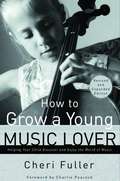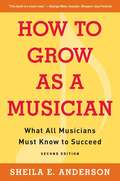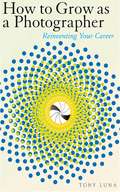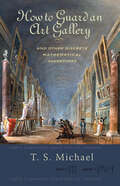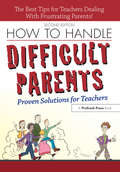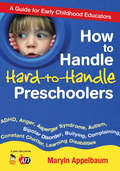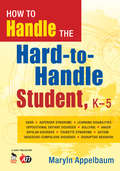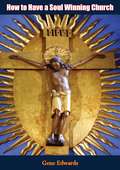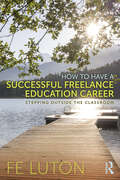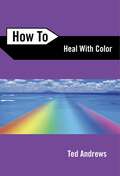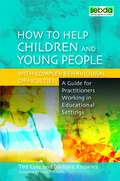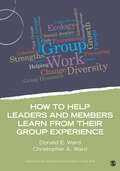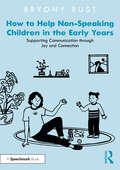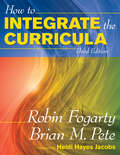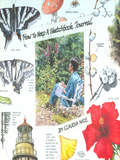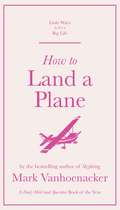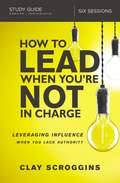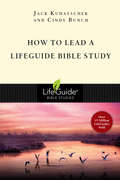- Table View
- List View
How to Grow a Young Music Lover
by Cheri FullerHow to Grow a Young Music Lover is the ideal guide for parents who want to boost their children's education through music; parents who want to aid in their children's cognitive, motor, and creative development; parents who love music and want their children to do the same; and parents who wish they knew more about music and want their children to have advantages and instruction they did not. The book is an extraordinary resource for homeschooling parents who want an informative, accessible music curriculum and those want to support their children's instruction in piano, violin, or other instruments. It is also greatly appreciated by grandparents and other caregivers who want to initiate kids into the world of music; early childhood and elementary educators interested in solid, practical ways to teach their classroom about music; and any reader interested in learning more about musical history, terms, and methods. The book will also be well received by fans of musician Charlie Peacock, who wrote the foreword for this new edition.From the Trade Paperback edition.
How to Grow as a Musician: What All Musicians Must Know to Succeed
by Sheila E. AndersonA Friendly Guide to Launching and Maintaining Your Musical Career It&’s tough to make a living from one&’s love of music, but Sheila E. Anderson shows readers how to do just that in How to Grow as a Musician. This encouraging yet realistic guide covers everything from developing and learning one&’s craft to managing the business aspects of a musical career. This second edition expands on performance tips, self-promotion tactics, and steps to improve one&’s networking skills to make fruitful connections. Anderson shares her insights as well as practical advice from successful musicians and other industry professionals on topics such as:Composing and recordingUnderstanding and negotiating contractsPutting on a performanceGetting and keeping gigsUtilizing social mediaAnd moreHow to Grow as a Musician is packed with candid views on everything from overcoming failure to the art of writing a song to doing that all-important ego check. Whether they&’re just getting started or have been in the business for years, all musicians will reap the rewards of this thoughtful career guide.
How to Grow as a Photographer: Reinventing Your Career
by Tony LunaAre you bored producing the same old work, but do it because it's safe? Are corporate politics, outsourcing, or the digital revolution too much for you to handle? Has a personal tragedy caused you to reevaluate your career path? If you answered yes to any of these questions, look no further than this inspirational guide. Topics include: --Recognize when something is wrong --Use work-history and personal timelines to meld your passions with your career choices --Reeducate yourself when faced with creative challenges --Embrace risk and evaluate your assets to make your next move --Sell your unique vision through a "Passion First" marketing approach --Manage your time and your business effectively --Use time-management techniques to stay focused and increase your creative output. You will also be inspired by the stories of other creative entrepreneurs who have made their own successful transitions. Whether you are a mid-career professional or just starting out, this book will set you on the path to creative and professional growth.
How to Guard an Art Gallery: And Other Discrete Mathematical Adventures
by T.S. MichaelAn “accessible and engaging” tool for understanding the branch of mathematics that is so crucial to modern computer science, using real-life problems (Mathematical Reviews).What is the maximum number of pizza slices one can get by making four straight cuts through a circular pizza? How does a computer determine the best set of pixels to represent a straight line on a computer screen? How many people at a minimum does it take to guard an art gallery?Discrete mathematics has the answer to these—and many other—questions of picking, choosing, and shuffling. T. S. Michael’s gem of a book brings this vital but tough-to-teach subject to life using examples from the real world and popular culture. Each chapter uses one problem—such as slicing a pizza—to detail key concepts about counting numbers and arranging finite sets. Michael takes a different perspective in tackling each of eight problems and explains them in differing degrees of generality, showing in the process how the same mathematical concepts appear in varied guises and contexts. In doing so, he imparts a broader understanding of the ideas underlying discrete mathematics and helps readers appreciate and understand mathematical thinking and discovery.This book explains the basic concepts of discrete mathematics and demonstrates how to apply them in largely nontechnical language. The explanations and formulas can be grasped with a basic understanding of linear equations.
How to Handle Difficult Parents: A Teacher's Survival Guide
by Suzanne Capek TingleyThis humorous handbook helps educators deal with impossible parents. Each chapter features a hilarious caricature that illuminates common parent anxieties followed by specific, practical methods for addressing the problem.
How to Handle Difficult Parents: Proven Solutions for Teachers
by Suzanne TingleyHow to Handle Difficult Parents is a funny, but practical, guide to working effectively with parents and avoiding unnecessary conflict. Whether you're a teacher (regular or special education) or a coach, this book will give you practical suggestions regarding what to say and how to say it to parents who question your lesson plans, challenge your disciplinary decisions, or threaten to tell the principal on you. Bringing years of experience as a teacher, principal, superintendent, and professor, the author shows teachers how to handle the most difficult parent types, including the Helicopter Mom, the Caped Crusader, Ms. “Quit Picking on My Kid,” The Intimidator, No Show's Dad, and Pinocchio's Mom, among others. Emphasizing ways to help create constructive conversation, this revised edition of How to Handle Difficult Parents is a must-have for teachers everywhere, both those just beginning and those already deep in the trenches.
How to Handle Hard-to-Handle Parents
by Maryln S. AppelbaumDiscover strategies for positive partnering with all parents—even the difficult ones! Creating successful relationships with all parents, including the most hard-to-handle ones, can be challenging for any educator. This book provides sample forms, letters, scenarios, and vignettes, plus techniques for involving families whose first language is not English. Readers will learn about: Establishing relationships with parents of all backgrounds Dealing with characteristics of difficult people and strategies to overcome adversity Being proactive in getting parents to follow through Conducting expert parent conferences Handling types such as “Know-It-All’s,” “Blamers,” and more
How to Handle Hard-to-Handle Preschoolers: A Guide for Early Childhood Educators
by Maryln AppelbaumEarly childhood educators know all too well how challenging and demanding pre-K children can be. But couple that with learning or behavioral disorders and teaching kids in the classroom can be even more of a challenge. How to Handle Hard-to-Handle Preschoolers is a user-friendly guide that provides early childhood teachers and administrators with a comprehensive overview of the most common kinds of behavioral disorders and learning disabilities in children ages two to five. This handy guide boasts hundreds of easy-to-implement strategies, tips, and techniques for managing behavioral disorders, from ADHD and biopolar disorder to Asperger syndrome and bullying tendencies. Each chapter covers one or more disorders and includes checklists to help educators better understand and manage hard-to-handle children.Maryln Appelbaum, owner of Appelbaum Training Institute--which trains over 50,000 preschool educators each year in the United States--illustrates ways to help young children learn how to develop the ability to regulate their own behavior, replace negative behaviors with more positive ones, handle their emotions appropriately, succeed in the classroom and everyday life, and problem solve. This book is sure to empower both new and veteran teachers with the tools necessary to transform a negative, disruptive classroom into a positive environment for learning.
How to Handle Hard-to-Handle Preschoolers: A Guide for Early Childhood Educators
by Maryln S. AppelbaumDiscover the key to better management of children’s challenging behaviors! This book provides educators of children ages 2 to 5 with strategies, tips, and techniques for managing various behavioral challenges and learning disabilities. Packed with hundreds of easy-to-implement ideas, this user-friendly resource provides a comprehensive overview of disorders from ADHD to Tourette’s syndrome and offers guidelines for meeting students’ needs within an inclusive environment. The author illustrates ways to help young children learn how to: Regulate their own behavior Solve problems Use alternatives to negative behaviors Handle their emotions appropriately Succeed in the classroom and in everyday life
How to Handle the Hard-to-Handle Student, K-5
by Maryln S. AppelbaumThe author helps teachers promote students' ability to handle emotions, regulate their own behavior, and learn in ways that meet their needs and those of the class.
How to Have a Soul Winning Church
by Gene Edwards“This book is for Christians whose hearts are on fire. This is for the visionary, the idealist. It is for the man who is not satisfied with the status quo in Christianity, and who believes that there is something big that can be done about it. This is for the Christian who believes the church and its people can be everything He wanted them to be—to fulfil the purpose for which he ordained them. This is for the spiritual optimist in a dark age.” (From the Author’s Introduction)
How to Have a Successful Freelance Education Career: Stepping Outside the Classroom
by Fe LutonTeaching and education offer a hugely rewarding career - but staying in the classroom for life is not always right for everyone. With a successful teaching career under her belt, Fe Luton made the move from classroom to kitchen table, entering the world of freelance education writing, research, and training as a general all-round creative. How to Have a Successful Freelance Education Career shares the options and practicalities of transitioning to and succeeding in a freelance career. Exploring options for both full-time and part-time freelancing, this essential guide outlines the key skills needed to build a stable career within the freelance education world. Fe Luton explores ways to define yourself, promote yourself and to make sure you stay top of the list when it comes to applications, commissions, and gigs. With chapters filled with practical advice, topics covered include: Life after (or alongside) teaching Developing skills beyond the classroom Pitching and making yourself stand out Building your online persona Career development The dos and don’ts of freelance work This engaging yet highly practical guide is an essential read for anyone looking to reassess their options in the world of education and to expand their professional horizons beyond the classroom.
How to Heal with Color
by Ted AndrewsEveryone is affected by color. We use colors to describe our physical health, our emotions, even our spiritual experiences. Now you can learn how to use color to restore health and balance energy.Popular author Ted Andrews presents an effective system for developing your innate healing skills, including a chart that lists the beneficial colors for over fifty physical conditions. With this easy-to-follow guide, you will learn the basics of color healing, why it works, and simple techniques for healing yourself and others using colored lights, candles, cloths, and charged water. Discover how to:Use color to balance and restore your energyDetermine which colors you need using simple assessmentsProject and absorb the healing properties of colorDevelop the ability to "sense" color with easy, fun exercises
How to Help Children and Young People with Complex Behavioural Difficulties
by Ted Cole Barbara Knowlesxx
How to Help Leaders and Members Learn from Their Group Experience (Group Work Practice Kit)
by Christopher A. Ward Donald E. WardA practical guide to maximizing learning in groups This easy-to-understand book provides practical strategies for helping members learn from their ongoing group experience, including guided illumination of selected group events. Real cases and practice exercises reinforce the importance of reflecting on your practice between group sessions. This brief guide draws on the latest research on group work, covering diversity and multicultural issues as well as accreditation or specialty standards. How to Help Leaders and Members Learn from Groups is part of the Group Work Practice Kit: Improving the Everyday Practice of Group Work, a collection of nine books each authored by scholars in the specific field of group work. To promote a consistent reading experience, the books in the collection conform to editor Robert K. Conyne’s outline. Designed to provide practitioners, instructors, students, and trainees with concrete direction for improving group work, the series provides thorough coverage of the entire span of group work practice. This book is endorsed by the Association for Specialists in Group Work.
How to Help Non-Speaking Children in the Early Years: Supporting Communication through Joy and Connection
by Bryony RustIn every setting there are children who struggle to communicate. When they’re not talking, or only using a handful of words, it can be hard to know how to help. In this book, you’ll be encouraged to spot early moments of communication and respond with clarity. You’ll find an invitation to stop doing and start noticing, to try new things and collaborate with the team around you.The book presents key concepts in bite-size chunks, with a wealth of real-life examples from speech therapy sessions and early years settings. It explores practical strategies to help children develop their foundational speech, language and communication skills, and includes fresh ideas to:· Build honest and supportive conversations with parents about communication needs· Value empathy and imagination as we tune in to each child’s world· Take a pro-neurodiversity lens to inform your practice· Measure progress and support professional development.Communication is core to our sense of wellbeing, personal agency and belonging. With a focus on fostering joyful moments of connection, this book offers a fresh perspective and a dose of encouragement for all early years practitioners, speech and language therapists, SENCOs and key people looking to support positive communication development in the children in their care.
How to Improve Your School
by David Woods Tim BrighouseThis best-selling book takes a practical look at how improvements can be made in any school.It cuts through the jargon of the specialist and shows how ideas and intentions can be turned into direct actions that will help a school improve its performance and effectiveness.As well as addressing headteachers and governors, the book will also provide invaluable guidance for all those who work in and with schools. There are chapters on:*effective schools and how they have achieved their goals*leadership within schools*teaching and learning effectively*making critical interventions to secure improvement*how schools involve others to aid improvement.This is a book that no school will want to be without. It is essential reading for anyone involved in education.Tim Brighouse is Chief Education Officer for Birmingham City Council and is a national figure in education. David Woods is a Senior Education Adviser at the DfEE.
How to Integrate the Curricula (Third Edition)
by Brian M. Pete Robin J. FogartyThis updated resource offers ten models that allow teachers to work together to create learner-centered classrooms by grouping elements from various content areas into a coherent, standards-based curriculum.
How to Interpret Data: Using Data to Improve Your Influence and Decision-making (Creating Success)
by Nicholas KellyThe best business decisions and strategies are always data-driven. Improve your understanding of data and your digital literacy with How to Interpret Data.Data is a cornerstone of our decision-making, but the ability to effectively interpret data is challenging to master. This book demystifies the process of data interpretation, providing you with the tools and knowledge you need to develop smart data-driven strategies.Packed full of fascinating interviews and stories which uncover the potential of data-driven strategies, this book will show you not only how to effectively interpret data, but will also uncover how you can use this knowledge to improve your decision-making and influence at work.
How to Keep a Sketchbook Journal
by Claudia NiceKeep a sketchbook journal and explore your world, preserve your thoughts and celebrate life!More than a diary of written words, a sketchbook journal allows you to indulge your imagination and exercise your artistic creativity. It is a personal, private place where you have unlimited freedom to express yourself, experiment, discover, dream and document your world. The possibilities are endless.In How to Keep a Sketchbook Journal, Claudia Nice shows you samples from her own journals and provides you with advice and encouragement for keeping your own. She reviews types of journals, from theme and garden journals to travel journals and fantasy sketchbooks, as well as the basic techniques for using pencils, pens, brushes, inks and watercolors to capture your thoughts and impressions.Exactly what goes in your journal is up to you. Sketch quickly to capture a thought or image before it vanishes. Draw or paint with care, to render an idea or vision as realistically as possible. Write about what you see. The choice is yours--and the memories you'll preserve will last a lifetime.
How to Land a Plane (Little Ways To Live A Big Life Ser. #1)
by Mark VanhoenackerTHE DAILY MAIL BOOK OF THE YEAR'Illuminates the practical reality of piloting in a concise and useful manner' Times Literary SupplementSo, hello! Welcome! Honestly, you look surprisingly relaxed. That's great to see. Have a seat on the left side of the cockpit - that's the captain's seat. Yes, that's right, you're now the captain, and yes, that's the runway down there. Fasten your seatbelt, order yourself a cup of tea, and let's get cracking.Mark Vanhoenacker, the airline pilot who makes poetry out of the science of flight technology, hands over the controls. Walking and talking us through the nitty-gritty of an approach and touchdown, he builds our understanding of flight from the ground up (or rather from the sky down), offering a new perspective of one of the more challenging and rewarding tasks ever.
How to Land a Plane (Little Ways to Live a Big Life #1)
by Mark VanhoenackerTHE DAILY MAIL BOOK OF THE YEAR'Illuminates the practical reality of piloting in a concise and useful manner' Times Literary SupplementSo, hello! Welcome! Honestly, you look surprisingly relaxed. That's great to see. Have a seat on the left side of the cockpit - that's the captain's seat. Yes, that's right, you're now the captain, and yes, that's the runway down there. Fasten your seatbelt, order yourself a cup of tea, and let's get cracking.Mark Vanhoenacker, the airline pilot who makes poetry out of the science of flight technology, hands over the controls. Walking and talking us through the nitty-gritty of an approach and touchdown, he builds our understanding of flight from the ground up (or rather from the sky down), offering a new perspective of one of the more challenging and rewarding tasks ever.
How to Lead When You're Not in Charge Study Guide: Leveraging Influence When You Lack Authority
by Clay ScrogginsThe greatest myth of leadership is that you must be in charge in order to lead.In this six-session, video study (DVD/streaming video sold separately), based on the How to Lead When You're Not in Charge book, Clay Scroggins shares his first-hand leadership experience as a pastor and his discovery that great leaders aren't paralyzed by not being in a position of recognized authority… Great leaders lead with or without that authority and learn to unleash their positive influence wherever they are.He explains the nature of leadership and what it takes to lead yourself and others well with or without that impressive title.In this study you will:Learn to leverage influence instead of authorityCreate a game plan for leading yourself well Change the energy of your team by choosing positivityCultivate influence by thinking critically, not being criticalAvoid the trap of passivity when you feel out of controlLearn an effective way to challenge people in authority over you How to Lead When You're Not in Charge Study Guide will free you to become the great leader you want to be so you can make a difference right where you are—whether it&’s in your workplace, community, or church. Even when you're not in charge.Sessions include: The Oddity of Leadership Lead Yourself Choose Positivity Think Critically Reject Passivity Challenging Up Designed for use with the How to Lead When You&’re Not in Charge Video Study 9780310095934 (sold separately).
How to Lead a Life of Crime
by Kirsten MillerA meth dealer. A prostitute. A serial killer. Anywhere else, they'd be vermin. At the Mandel Academy, they're called prodigies. The most exclusive school in New York City has been training young criminals for over a century. Only the most ruthless students are allowed to graduate. The rest disappear. Flick, a teenage pickpocket, has risen to the top of his class. But then Mandel recruits a fierce new competitor who also happens to be Flick's old flame. They've been told only one of them will make it out of the Mandel Academy. Will they find a way to save each other--or will the school destroy them both?
How to Lead a LifeGuide® Bible Study (LifeGuide Bible Studies)
by Jack Kuhatschek Cindy Bunchhow to start a grouphow to decide what to studyhow to prepare to leadhow to study the Biblehow to use a study guidehow to write your own questionshow to lead the discussionhow to evaluate the study
